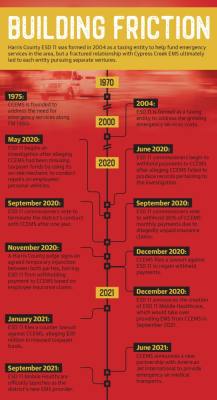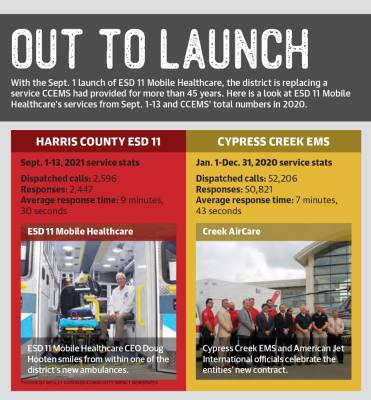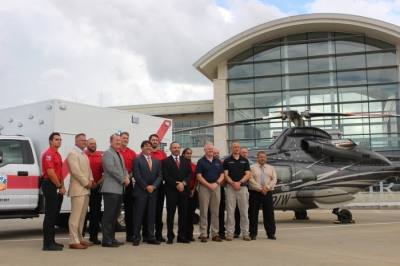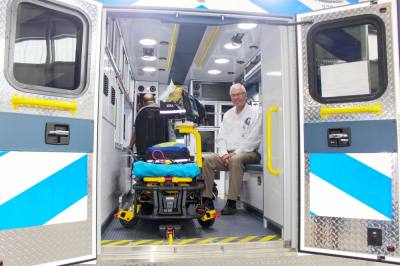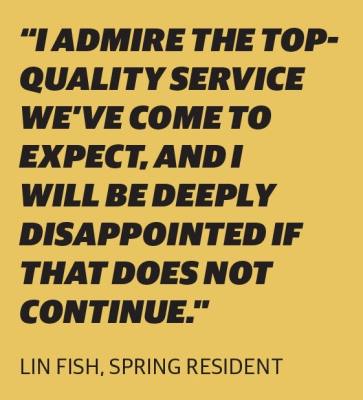Dick Eckert’s death prompted fellow Cypresswood residents Cliff and Kati Woodward to take action with other residents living near FM 1960 in Spring to form what eventually became Cypress Creek Emergency Medical Services in 1975.
Now, more than 45 years later, the EMS provider is still going strong, although several years of building acrimony with Harris County Emergency Services District 11, which began contracting with CCEMS upon its creation in 2004, has forced the EMS provider to pursue separate ventures.
On Sept. 1, the district launched ESD 11 Mobile Healthcare to take over providing emergency services to over 600,000 residents across 177 square miles in its service area in north Harris County. Meanwhile, CCEMS signed a contract with American Jet International in June to provide emergency air medical transports. Additionally, the EMS provider will continue to provide ground care and event services as well as educational opportunities for emergency and health care workers.
CCEMS’ beginnings
According to Cliff Woodward, the biggest early hurdle of creating a new EMS provider from scratch in 1975 was funding.
“We all looked at each other ... and said, ‘How the hell are we going to raise $105,000?’” he said.
Cliff Woodward began to travel door to door in area neighborhoods to ask for assistance and spoke at local meetings to explain the need for ambulance services within the community.
To help promote the project, Kati Woodward came up with a name for the venture that she thought would help unify potential donors.
“I based the name on what connected such a big area,” said Kati, who wrote CCEMS’ bylaws.
Eventually, volunteers were able to secure more than $110,000 from roughly 5,000 contributors, and on Dec. 14, 1975, the first ambulance bearing the name Cypress Creek EMS was put into service.
Between 2010-20, the EMS provider responded to more than 455,000 calls and transported more than 275,000 patients, CCEMS officials said.
“So many people have been served at a critical time, and so many lives have been saved because of the service,” Cliff Woodward said. “If there’s a key into heaven, this is mine.”
A simmering feud
While CCEMS was initially funded entirely by donations and money taken in from service fees, Harris County’s population—which grew by more than 580,000 residents from 1990 to 2000, according to U.S. Census Bureau data—prompted the need for additional sources of revenue.
The creation of ESD 11 was approved by voters in 2004 to serve as a taxing entity to help fund emergency services in the area.
Upon its formation, ESD 11 commissioners approved a contract with CCEMS to continue providing ambulance services within the district, which was renewed annually until September 2020, when a feud between the two entities reached its boiling point.
At a May 2020 ESD 11 board meeting, commissioners alleged CCEMS had been misusing taxpayer funds by using its on-site mechanic to conduct repairs on employees’ personal vehicles. That September, commissioners voted to terminate the district’s service agreement with the EMS provider, claiming CCEMS officials had repeatedly refused to disclose financial documents needed for the district’s investigation into the potential misuse of funds.
Two months later, ESD 11 commissioners announced the district would launch its own EMS provider—ESD 11 Mobile Healthcare—but the two entities continued to spar throughout the final year of their contract.
In December, CCEMS filed a lawsuit against ESD 11 after the district withheld portions of CCEMS’ monthly invoice from June through November.
ESD 11 officials initially withheld payment because of documents that were allegedly withheld and pertained to the investigation. Commissioners voted later that year to withhold 30% of CCEMS’ invoices due to allegations of unpaid employee insurance claims.
ESD 11 commissioners filed a counter lawsuit in January, claiming CCEMS stole up to $20 million in taxpayer funds, in part through the alleged vehicle repairs.
ESD 11 Special Counsel Brian Trachtenberg said both lawsuits are currently active.
“The district is aggressively pursuing its claims to recover taxpayer dollars from CCEMS and its affiliates,” he said. “The district also continues to defend itself against what remains of CCEMS’ claims.”
To date, Trachtenberg said the district has spent $250,000 in attorney fees on the lawsuits.
CCEMS spokesperson Miranda Sevcik said an estimate of attorney fees related to the lawsuit was not available as of press time Sept. 15.
Spring resident Lin Fish said the friction and competing lawsuits between the two entities caused her to attend almost every public meeting held by ESD 11 this year.
“I admire the top-quality service we’ve come to expect, and I will be deeply disappointed if that does not continue,” Fish said.
Looking toward the future
Since its Sept. 1 launch, ESD 11 Mobile Healthcare CEO Doug Hooten said the district is looking to move forward.
Jerry Thomas, ESD 11 Mobile Healthcare’s community engagement manager, said dispatch received roughly 2,600 calls resulting in 1,420 transports from Sept. 1-13. Thomas noted the average response time for ambulances to life-threatening emergencies has been just under 9 minutes and 30 seconds.
“It is important to note that not all calls require an ambulance response based on a patient’s medical priorities,” Thomas said. “We strive to get the right ambulance to the right patient at the right time.”
Hooten, who previously served as CEO of the Metropolitan Area EMS Authority/MedStar Mobile Healthcare in Fort Worth, was appointed ESD 11 Mobile Healthcare’s CEO in December.
According to Hooten, one aspect of a mobile health care system is providing proactive care, which means getting to know the individuals who commonly call 911 for nonemergencies.
“[The question becomes,] ‘How do we establish the root cause of why you’re calling and become better able to help you learn how to navigate the health care system?’” Hooten said.
Additionally, Hooten said ESD 11 Mobile Healthcare is working alongside local police agencies to develop a mental health response initiative.
The projected annual cost of operating ESD 11 Mobile Healthcare is hard to determine, Hooten said, as the entity has not yet had a full operating year. Additionally, the district incurred debt to purchase 40 new ambulances at roughly $254,000 each plus another $2.4 million to renovate its headquarters.
ESD 11 paid about $1.3 million per month in 2020 to contract CCEMS—roughly half of CCEMS’ total budget. Hooten said he thinks ESD 11 Mobile Healthcare can operate at about $6 million less annually.
“I think if we can do this the way we plan to do this, we’ll be able to retire debt ... within 10 years probably,” he said. “I think it will be self-sufficient.”
Taking flight
For CCEMS, the future, at least in part, will be found in the sky. In June, CCEMS CEO Wren Nealy signed an agreement with American Jet International—an on-demand aircraft charter company—to provide a medical flight crew and equipment to assist with medical transports throughout the nation and abroad.
“AJI and CCEMS partnered to provide our staff for its flights because AJI wants the best,” Nealy said. “We are excited to grow with AJI and see endless opportunities ahead.”
Nealy noted the service—dubbed Creek AirCare—is one of several ways CCEMS is evolving.
“We are expanding our brand, no more limitations, no more borders,” Nealy said, noting CCEMS would also continue to prove ground medical transports through a contract with CHI St. Luke’s Health in Houston.
Nealy said CCEMS will also continue to offer educational opportunities for emergency medical technicians, paramedics and other health care professionals. Over the past five years, CCEMS has graduated more than 1,100 EMT and 200 paramedic students.
“This is a glimpse into what Cypress Creek [EMS] is going to be for the next 46 years,” Nealy said.





